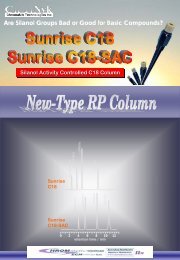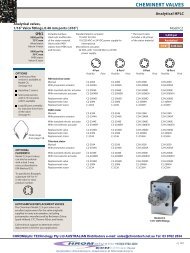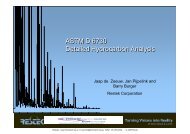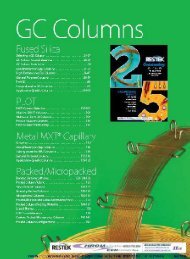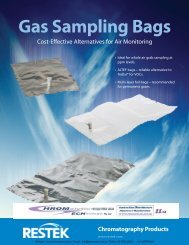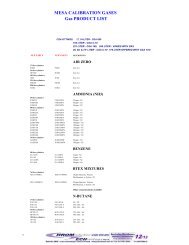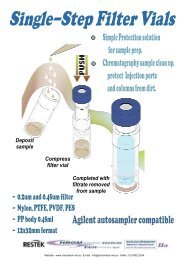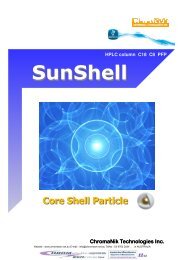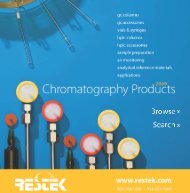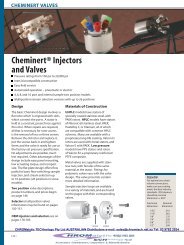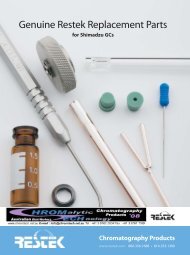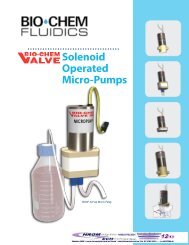Fast GC Using Minibore Fused Silica Capillary Columns Introduction ...
Fast GC Using Minibore Fused Silica Capillary Columns Introduction ...
Fast GC Using Minibore Fused Silica Capillary Columns Introduction ...
Create successful ePaper yourself
Turn your PDF publications into a flip-book with our unique Google optimized e-Paper software.
<strong>Fast</strong> <strong>GC</strong> <strong>Using</strong> <strong>Minibore</strong> <strong>Fused</strong> <strong>Silica</strong> <strong>Capillary</strong><strong>Columns</strong><strong>Introduction</strong>• Benefits• Capacity Considerations• Equipment Considerations• SamplesKristi Sellers, Sherry Sponsler, and Frank DormanPittCon 1997, Atlanta GAReducing instrument & operator time for gas chromatographic analyses has become an importantconsideration for many laboratories. The use of minibore (0.10mm ID) columns can significantlyreduce analysis time without sacrificing resolution. The extremely high efficiency of miniborecolumns (~7000 plates/meter) can provide resolution of complex mixtures while using shorterlengths. Shorter columns are less expensive and reduce analysis times, resulting in a cost savingsfor the lab.Benefits• <strong>Fast</strong>er analysis times• Similar resolution for complex mixturesLower costBenefitsSome instrument companies have been promoting the benefits of fast screening columns, but thesacrifices required aren't always evident from their literature. The reduction of analysis time at theexpense of resolution, sample capacity, and ease of use is not always an acceptable alternative. Thisarticle will discuss and demonstrate the benefits and limitations of 0.10mm ID columns.FAME AnalysisA: Rtx-Wax 30m X 0.25mm ID X 0.25µm dfB: Rtx-Wax 20m X 0.10mm ID X 0.20µm dfThe following four chromatograms are examples of typicalanalyses of minibore columns. For example, this FAMEanalysis analyzed on a conventional column gives an analysistime of 23 minutes. On the minibore column, the analysis timeis 13 minutes. Notice that there is no loss of resolution.The fragrance, PAH and chlorinated pesticideschromatograms are more examples of minibore analyses showing shorteranalysis times without loss of resolution.
Fragrance Components1mm ID Liner, 55°C Initial Temp.Fragrance Analysis on Rtx-Wax10m x .10mm ID x .20um dfPolynuclear AromaticHydrocarbonsRtx-5 10m X 0.10mm ID X 0.10µm dfChlorinated PesticidesRtx-5 10m X0.10mm ID X 0.10µm dfCapacityColumn ID 0.10mm 0.18mm 0.25mm 0.32mm 0.53mmSample Capacity (ng) 5-10 10-20 50-100 400-500 1000-2000He flow@20cm/sec. 0.1cc/min. 0.3cc/min. 0.7cc/min. 1.0cc/min. 2.6cc/min.H 2 flow@40cm/sec. 0.2cc/min. 0.6cc/min. 1.4cc/min. 2.0cc/min. 5.2cc/min.Theoretical Plates/m 8600 5300 3300 2700 1600Effective Plates/m 6700 3900 2500 2100 1200Speed and ResolutionThe capacity table compares the characteristics of minibore columns to conventional columns. Thisdata holds the key to whether minibore columns are right for your analysis. The most strikingdifference of minibore columns is their high efficiency (plates/meter) compared to other diameters.This table indicates that a 0.10mm ID column is 160% more efficient than a 0.25mm ID column. Thishigh efficiency allows shorter columns to maintain excellent resolution and increase the speed ofanalysis. However, some of the other parameters in the table illustrate limitations that may negate theusefulness of minibore columns in your laboratory. The effect of low flow rates, low sample capacity,and high operating pressures on your sample requirements will ultimately determine if miniborecolumns are an improvement for your laboratory.Flow RatesThe low flow rates for minibore columns can be either an advantage or a limitation. Low flow rates arebeneficial for <strong>GC</strong>/MS users because the flow rates are well within the pumping capacity of mostsystems. In addition, the minibore prevents "pumping out the column" or operation below atmosphericpressure. This provides more efficiency for the end user. However, low flow rates also translate intomore flow path problems for the chromatographer. Unswept dead volume has disastrous consequences
Capacity Considerations• Amount on column• Overloading• Injection methodsSample CapacityA limiting factor of a minibore column is the amount of sample that can be injected onto the column.The table indicates that the sample capacity of a minibore column is ten times less than a 0.25mm IDcolumn. Therefore, the on-column injection should be at least ten times lower for a minibore column.Overloading Causes Problems:• Resolution• Integration• Retention timeLinearityOverloading can also be a concern when using a minibore column. When the column's samplecapacity is exceeded, peak fronting (overloading) can occur resulting in poor resolution, poorintegration, irreproducible retention times, and poor linearity.speed, resolution, flow rate, operating pressure, sample capacity and overloading are all factors thatmust be taken into consideration when choosing minibore columns and the correct injection mwhtodfor your analysis.Injection Technique• Compatible:• Split• Splitless• Incompatible:• Direct• On-ColumnInjector ConsiderationsDirect and on-column injection modes are not recommended due to the required low flow rates andsmall bore size of these columns. Therefore, trace analyses are difficult to perform with miniborecolumns. Split and splitless injections are the best alternatives. However, since minibore columnsrequire low flow rates, speed of sample transfer through the liner to the column is a concern. Due tothe high dead volume, poor peak shape, and response, loss of resolution will occur when 2 or 4mmID liners are used in conjunction with minibore columns. Thus, 1mm ID inlet liners are a must forsharp, well resolved, and recovered peaks. Not only is the inlet liner a consideration when usingminibore columns for split or splitless injections, but other parameters specific to the type ofinjection method must also be optimized.
Split Injection• Inlet Liner• TemperatureIn a split injection, the choice of inlet liner and initial temperature will affect peak shape, response,and resolution the most.Inlet Liner Volume Effect4mm ID Liner, 90°C Initial TemperatureFragrance Analysis on Rtx-Wax 10m x .10mm IDx .20um dfA typical fragrance analysis on a conventionalcolumn (0.32mm ID) under optimal conditions (4mmID inlet liner and 75°C initial temperature) exhibitsan analysis time of more than 70 minutes and theseparation of vanillin and musk xylol is not achieved.When only changing to a 0.10mm ID column, the analysis time was reduced to 10 minutes.However, poor peak shape and poor recovery of the early eluting peaks also resulted.Optimized Liner Volume1mm ID Liner, 90°C Initial TemperatureFragrance Analysis on Rtx-Wax 10m x .10mm IDx .20umdfBy optimizing the inlet liner (1mm ID), not only didthe analysis time reproduce (10 minutes) but the peakshape of the early eluters also improved. However,recovery of the early eluting peaks is not yet acceptable.Optimized Inlet Liner and Temp.Program1mm ID Liner, 55°C Initial Temp.Fragrance Analysis on Rtx-Wax 10m x .10mm IDx .20um dfWhen the inlet liner (1 mm ID) and the entiretemperature program are optimized (55°C initialtemperature), full recovery and excellent peak shapeof early eluters were attained as well as reduced analysis time (18 minutes) and 80% resolution ofvanillin and musk xylol.Splitless Injection• Inlet Liner• Inlet Pressure• ContaminationIn splitless injection, inlet liner, inlet pressure and sample cleanliness must be considered.
Optimized Liner and PressureProgramRtx-5 10m X0.10mm ID x 0.10µm df1mm ID inlet linerThis chromatogram illustrates a splitless PAHanalysis on a 10m, 0.10mm ID, 0.10µm Rtx®-5using an optimized inlet liner and inlet pressure.Conventional Liner ConstantPressureRtx-5 10m x 0.10mm ID X 0.10µm df2mm ID inlet linerWhen a 2mm ID inlet liner was used, highmolecular weight discrimination occurred.Optimized Liner ConstantPressureRtx-5 10m X0.10mm ID x 0.10µm df1mm ID inlet linerBy changing to a 1mm ID inlet liner, highmolecular weight discrimination was eliminated.However, this change caused peak splitting of theearly eluting compounds. The peak splitting waseliminated completely when pressure programming was applied in place of constant pressure.Sample cleanliness is another important factor to take into consideration when using miniborecolumns. Because the surface area of the 0.10mm ID columns is much lower than a conventionalcolumn, contamination will occur more rapidly when dirty samples are injected. This means that0.25 or 0.32 mm ID columns will be more rugged and require less maintenance for dirty samplesthan minibore columns. Whenever possible, samples containing non-volatile residue should beavoided. If dirty samples are a must, extensive column and injection port maintenance is required.Otherwise, loss of resolution, ghost peaks, and a high background signal will result.Detector• Increased make up gas• Increased S/N with high speed <strong>GC</strong>• <strong>Fast</strong>er scanning ratesDetector ConsiderationsDetector design and flows must be optimized when using minibore columns. Make up gas flowsmay need to be increased to minimize detector dead volume and compensate for the lower columnflow rates.
Sampling Rate and Signal to Noise RatioSince peak widths are approximately half compared toconventional columns (< 1 second), fast integrator and detectorelectrometers must be used. Integrator sampling rates must beincreased over rates used for 0.25mm ID columns since the peaksare much narrower with minibores. If the sampling rate is tooslow, then poor integration and non-reproducible peak areas willresult. Check with your instrument company and data system manufacturer to be sure your systemis capable of handling minibore sampling rates.FootnoteSRI <strong>GC</strong>s PeakSimple Data System #203 has a maximum samplung rate of 50 HZfor quantitation an A/D sampling rate should be fast enough to scan 12 times across the peakFor HIGH SPEED <strong>GC</strong> using this system at 50Hz the chromatography should limit peak widths toapprox 0.25sec ( minmum )Suggestion - probably a practical limit for such a system combined with fast temperatureprogramming limited to 10m 0.18mmID columns programmed at up to 250 deg-C/min ( ezFLASH<strong>GC</strong> ) over a 2 to 3 min analysis periodNOTE Information from OEMs regarding FID electrometer time constants and A/D Data Systemspeeds is rareShimadzu with their 2002 Model #2010 <strong>GC</strong> offer 250 deg-C temp programming and Detector A/Dsampling rates of 250Hz for HIGH SPEED <strong>GC</strong>Summary• Benefits• Shorter analysis times• Similar resolution• Lower cost• Considerations• Capacity• Injector• Detector• Samples<strong>Minibore</strong> columns can produce shorter analysis times, equivalent resolution, and provide costsavings. But remember, converting your conventional system to a minibore system isn't as easy aschanging columns. Column capacity, sample purity, and injector and detector conditions must beconsidered and optimized for a successful analysis. Keep in mind that when switching fromconventional capillaries to minibore columns, there may be the need to optimize inlet temperatures,liners, and <strong>GC</strong> run conditions.



